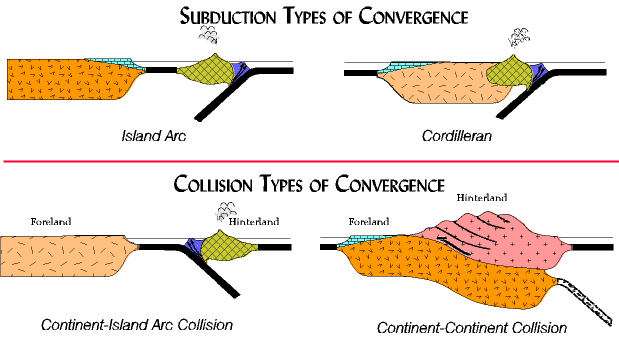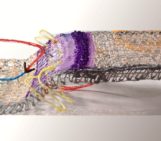
Long after the first attempts made by Wegener (1915), the theory of plate tectonics was progressively accepted by the Earth sciences community in the thrilling ‘60s thanks to observations from mid-ocean ridges (see TS-must-read blogpost of September 2, 2020; Dietz, 1961; Heezen and Tharp, 1965, Hess, 1962; Vine and Matthews, 1963). The question is then, what goes on at convergent boundaries, where the oceanic lithosphere underthrusts the continental lithosphere? Well, here is Dewey and Bird’s (1970) point: mountain belts, helped by a waltz of island arcs and continents.
The scientific breath of their contribution makes it a landmark paper. Dewey and Bird integrate the sedimentary history of continental passive margins, and their reactivation in compression by thrust-dominated deformation, eventually recording the high-pressure and high-temperature metamorphic belt couple of Miyashiro (1961). Contrarily, oceanic lithosphere subducts and causes arc magmatism. By this, the paper lays down several plate tectonic facts every student in Earth Sciences has heard once, and hopefully remembers. The link between the distance of the volcanic arc to the trench and the inclination of the subducting slab, for example. With a pinch of uniformitarianism, they reconcile the comprehension of ancient, eroded mountain belts, and modern homologous, visiting and describing archetypal examples for each Wilson cycle step (see TS-must-read blogpost of October 13, 2020; Wilson, 1966): it is worth reading it while traveling from place to place using Google Earth!
The manuscript’s core conclusion is that there are two major ways to build orogens on Earth by plate tectonics. First, where oceanic lithosphere subducts below a continent, a cordilleran-type mountain belt forms, such as the Andes and the Pacific coast of N. America. The authors’ point is that this type of orogen originates from the reactivation of a continental passive margin (Atlantic-type) to an active continental margin (Pacific-type), and its growth is driven thermally by arc magmatism and high-temperature metamorphism. Second, where an island arc, or ultimately a continent, collides onto a passive continental margin: a collisional-type mountain belt forms, such as New Guinea in Miocene times or eventually the Himalayas. These collisional-type orogens are driven by mechanical accretion.

Figure 1: Drawings illustrating the two types of mountain belts identified by Dewey and Bird (1970): the cordilleran-type (subduction type) and the collision-type. From Fichter (2000).
By this, the reader can come to the same point made by Christoph von Hagke on the reddit thread: the lesson to be learned reading Dewey and Bird’s paper is that the key to understanding mountain belts lies in the ocean. One may go one step further by stating that the key to understanding a mountain belt lies in the oceanic material it hosts: ophiolites, the sediments and their metamorphism, the magmatic products resulting from the oceanic lithosphere subduction… Such an approach, where geology takes on its full meaning, still serves today to tackle controversial questions such as the size of the Tethyan ocean (McCarthy et al., 2020).
Some detailed processes may still be questionable to some extent: how does this concept apply to the Pacific, existing since the Precambrian with a long-lived arc and microcontinent accretion history along its coasts (notably its Eurasian side; Şengör et al., 1993)? Are passive margins really able to self-reactivate or do they need a little help from existing subductions propagating through oceanic domains (Duarte et al., 2013)? These questions, still explored and hotly debated by the community, really shows the robustness, the importance and the ability of Dewey and Bird’s 50 years old contribution to inspire multiple generations of Earth scientists.
Written by Benoît Petri, Utsav Mannu, and Patricia Cadenas Martínez and the TS Must Read team.
References:
Dewey, J.F., Bird, J.M., 1970. Mountain belts and the new global tectonics. J. Geophys. Res. 75, 2625–2647. https://doi.org/10.1029/JB075i014p02625
Dietz, R.S., 1961. Continent and Ocean Basin Evolution by Spreading of the Sea Floor. Nature 190, 854–857. https://doi.org/10.1038/190854a0
Duarte, J.C., Rosas, F.M., Terrinha, P., Schellart, W.P., Boutelier, D., Gutscher, M.-A., Ribeiro, A., 2013. Are subduction zones invading the Atlantic? Evidence from the southwest Iberia margin. Geology 41, 839–842. https://doi.org/10.1130/G34100.1
Fichter, L.S., 2000. Plate boundaries and interplate relationships [WWW Document]. URL http://csmgeo.csm.jmu.edu/geollab/Fichter/plateTect/plates.html (accessed 10.19.20).
Heezen, B.C., Tharp, M., 1965. Tectonic fabric of the Atlantic and Indian oceans and continental drift. Philos. Trans. R. Soc. London. Ser. A, Math. Phys. Sci. 258, 90–106. https://doi.org/10.1098/rsta.1965.0024
Hess, H.H., 1962. History of Ocean Basins, in: Petrologic Studies. Geological Society of America, USA, pp. 599–620. https://doi.org/10.1130/Petrologic.1962.599
McCarthy, A., Tugend, J., Mohn, G., Candioti, L., Chelle-Michou, C., Arculus, R., Schmalholz, S.M., Müntener, O., 2020. A case of Ampferer-type subduction and consequences for the Alps and the Pyrenees. Am. J. Sci. 320, 313–372. https://doi.org/10.2475/04.2020.01
Miyashiro, A., 1961. Evolution of Metamorphic Belts. J. Petrol. 2, 277–311. https://doi.org/10.1093/petrology/2.3.277
Şengör, A.M.C., Natal’in, B.A., Burtman, V.S., 1993. Evolution of the Altaid tectonic collage and Palaeozoic crustal growth in Eurasia. Nature 364, 299–307. https://doi.org/10.1038/364299a0
Vine, F.J., Matthews, D.H., 1963. Magnetic Anomalies Over Oceanic Ridges. Nature 199, 947–949. https://doi.org/10.1038/199947a0
Wegener, A., 1915. Die Entstehung der Kontinente und Ozeane. Friedrick Vieweg und Sohn, Brunswick.
Wilson, J.T., 1966. Did the Atlantic Close and then Re-Open? Nature 211, 676–681. https://doi.org/10.1038/211676a0


